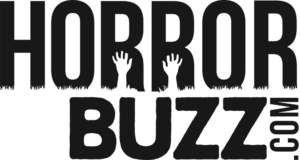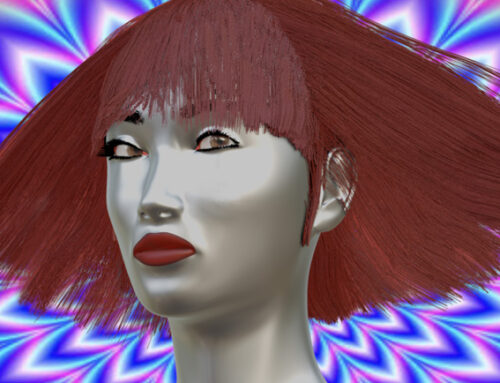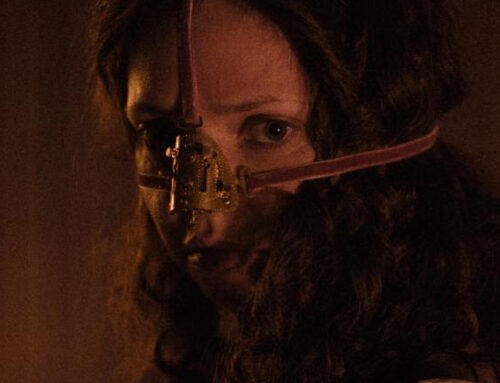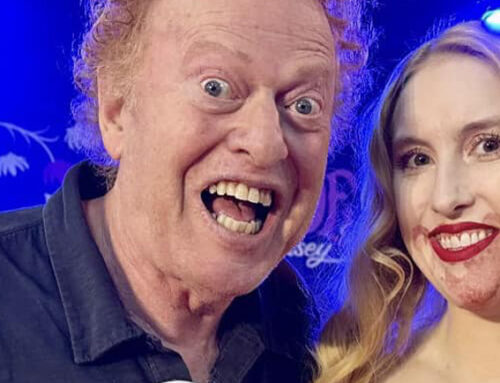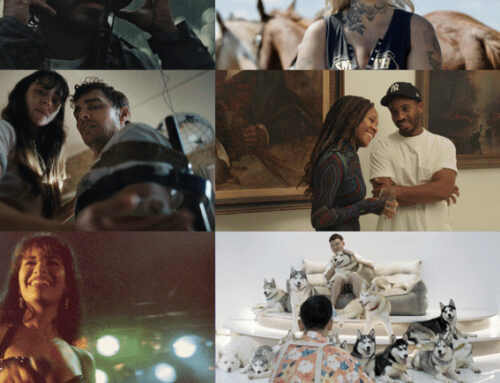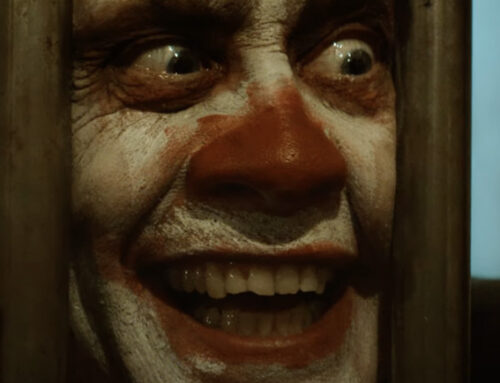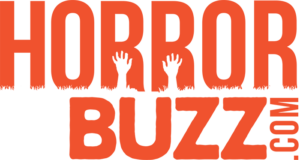Audiences who enjoyed 90s slashers such as I Know What You Did Last Summer and Urban Legend are in for a treat, as Netflix just released a Spanish slasher, Killer Book Club. Just like I Know What You Did Last Summer and Urban Legend, an accidental death soon finds a group of kids getting picked off one by one in a game of revenge. The IMDB synopsis reads: After being complicit in a costume joke that ends in a fatal accident and a pact of silence, a group of young people will be threatened by an anonymous writer who wants to reveal his dark secret. Their stalker threatens to post a bloody horror novel based on them on social media. Each chapter one of them will die. While distrusting each other, the group will begin a fight for survival in the middle of the university campus. Any one of them could be the next victim, or the killer.
Whether it be an abandoned warehouse or an extensive library, the production design in Killer Book Club plays a key role in the unfolding story. To learn more about how the look of Killer Book Club was created, we spoke to the film’s production designer Markos Keyto below.
How long did you prep for Killer Book Club and how long was the actual shoot?
We started from scratch in mid-November 2021, still with COVID controls and restrictions, and for about nine weeks we put together the visual book, created the concept, developed the characters, planned the deaths, scouted the locations, and got to work with the construction. It wasn’t easy. Initially, the planned locations did not fit the ideas that we had, so the scouting process overlapped with the entire visual design to be able to arrive on time for the shoot.
I like the fact that the result looks easy because that means we did it right, but the truth is that the complications weren’t few. Finding a place where we could recreate the university campus was paramount because ninety percent of the scenes took place there, and with all the twists, with the demands of the script, it was not only not easy, but also impossible. Added to this were administrative and production problems, so I considered making a “Frankenstein” of locations; this led Carlos, the director, and myself to visit many places, at the same time that period was perhaps the most creative and productive because during all these visits we were defining everything in the same way that we were imagining it. The execution and construction of everything took place almost in parallel to the filming and that led us to live the six weeks that the shoot lasted with great intensity.
Did you always know Killer Book Club was going to be on Netflix or did they buy it later on?
I knew from the beginning that Netflix would be the platform that would take this forward, in fact we had quite a few meetings where the whole visual concept was presented to the executives. The idea was to make a fairly international product, it was part of the assignment I had, to give the story a look that would not limit us to a single country. The truth is that despite the fact that Netflix was behind the entire project, I felt very free in making decisions.
There are a lot of grand sets in the film. Did you have to lend your expertise to all of those or were you able to use some of the sets as is? Such as the classrooms and library?
On the one hand, I like this question, since from it I perceive that all my interventions went unnoticed, but on the other hand, I dislike the idea that many times it is thought that the camera arrives at a place and simply films. Nor is it an offense, since even the locations that work without intervention are chosen following the criteria of the production design, but the truth is that in this film, we intervened and redesigned each space that we used. It was important to give an aesthetic coherence to the whole film, I think the style works very well and this is because each place acquired the desired personality.
For example, the university is made up of at least seven different buildings and from different cities, there are even persecutions that are supposed to be in the same place that were filmed in at least five different locations. Imagine the previous search work to find coherence and everything that goes into creating an atmosphere that makes us feel that we are in the same place.
Precisely, you ask about the library, and here there was a rather complex job since I loved a certain place for its architecture, but nevertheless it lacked all the necessary elements to recreate the library, and also we only had one room, when what we were looking for was having the reading area on one side and the forest of shelves on the other; well both areas were created in the same place, creating a mirror effect that made us feel that both rooms were symmetrically opposed and that they were connected to each other. We built all the shelves, which were custom designed so that the camera could make the necessary movements and turns and so that the frames worked as we wanted. We also had to think about the amount of time that we had to dismantle and reassemble the library, because as I was saying, both environments took place in the same room and we would shoot everything in a single day. For this purpose, light shelves with hidden wheels were designed to facilitate the operation; at the same time these same shelves were prepared to be transformed and readapted for the house of the fire, which we would shoot in another location, and that we also had to reproduce later on in a safe studio to set it on fire.
It was all very crazy and several thousand books were prepared for these scenes, many of them designed as horror books by us to give more credibility to the story. These same books and even part of the shelves were later used to create the book fair as well.
How much did you have to design the abandoned room where they all make the pact and burn the masks?
We wanted to have exactly what we had, my proposals to the localization team were very specific, and Nuria and Silvia, our localization team, understood it perfectly. There was a school that had an abandoned swimming pool and we went there. The place was ideal but it lacked character, and I also wanted it to be in line with what we were looking for. First, for the safety of our crew and the actors, we decided to clean it thoroughly and then with the space as a canvas, we were the ones who gave it the character that we wanted. We added trees and trucks of dry leaves, we looked for wood and furniture that would give us that aspect of abandonment; Ana Medina, my Art Director, found some old pool seats and a multitude of objects with which we decorated our set. We also filled the walls of the pool with graffiti that contain crypto messages.
Each of the characters in the film have a distinct persona. Which character’s space did you have the most fun with?
Yes, the writer (Carlos G. Miranda) had created very stereotyped characters and the director (Carlos Alonso) and I decided to mark them much more to the point of almost turning them into comic book characters. It was very important to keep the spirit of what the writer had given us, but at the same time we wanted to help the characters with their wardrobe, makeup and everything around them. We did a very interesting team work. My colleague in the wardrobe department, Matías Ripoll, helped me a lot to configure the aesthetics based on the personality of each one of them, and Cruz Puente perfectly defined what we wanted our characters to convey through hair and makeup.
They were all very fun for me, but there are two of them that that are my favorite ones. On the one hand, Angela (Veki Vellila), our protagonist, given that it posed the challenge of transforming a sweet and scared girl, full of insecurities, into a heroine, in the style of “Ellen Ripley”. And on the other hand, our antagonist Alicia/Virginia (Priscilla Delgado); In this case, it was a wonderful toy, a hidden monster in that artist girl, introverted, tormented and misunderstood, but with that air of a schoolgirl.
What was different about this film, then others you have worked on in the past?
They are all different. I make films because they allow me to experience different realities continuously.
In this case, the fact that I worked surrounded by great talents from my country was wonderful. The truth is that I have not worked much in Spain, my career has developed more between Italy and the United States, and so this was a wonderful and special experience. The relationship that was established between all the members of the team was unusual. We filmed a couple of years ago and we are still all communicating in a WhatsApp group that we created during filming.
You worked on the horror film Til Death Do Us Part, which was also recently released. Is it a coincidence or do you enjoy working in the horror genre?
I love making horror movies, but I work in many other genres. I have done westerns, dramas, wars, period, dystopias, science fiction, etc. I like to tell stories in a visual way, and I care a lot about the script and what we want to convey to the viewer, without caring too much about the genre, but yes, horror is without a doubt a very stimulating genre, since it allows me to send hidden messages and create stress at the right times. Furthermore, in many cases, in horror, the space, the house, the cemetery, etc., the place itself is an absolute character and that allows me to deepen its design.
Although it may sound pretentious to some, my intention is always to create visual poetry, and horror allows you many things, sometimes I feel like Edgar Allan Poe, sometimes Lord Byron, sometimes Mary Shelley.
Do you think the horror genre allows you to be a little bit more over the top with your work compared to other genres?
I am very exaggerated with everything always. And very detailed too. I fill all my movies with hidden messages. I try to tell everything that appears in the script and much more through objects, textures, lights, compositions, etc. There are many details that the average viewer does not manage to perceive in a conscious way but that nonetheless affect their way of seeing, understanding and feeling the place.
Horror is undoubtedly a genre in which one can develop tremendously, but if I have to say something, there are many people who think that horror is easy, because it is gimmicky; some think it’s a minor genre, and I’ve even heard fellow Production Designers put down the artists who work on these movies as “only putting up candles, chandeliers and cobwebs”. How wrong they are or how little have they understood everything that can be said from our position to the viewer. A horror movie is a gift, and you have to know how to get the most out of it.
Having said this, I propose the following challenge to you. Now that you have read this interview, try to watch the film again and see it with different eyes, look for the hidden gifts, the hidden plots or at least enjoy the references to great masters, who are not exactly what you imagine, no, no, they are not the ones from the slasher or horror movies that may first come to mind…
…And you want to tell me what you found or where you got lost, find me.
